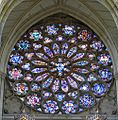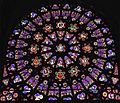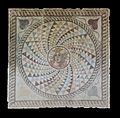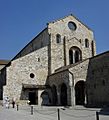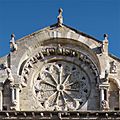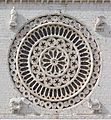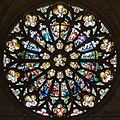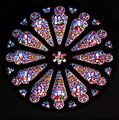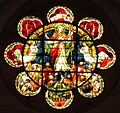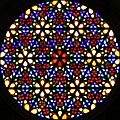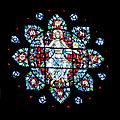Rose window facts for kids
A rose window is a special kind of round window often found in old churches, especially those built in the Gothic style. It gets its name because its design looks a lot like the many petals of a rose. These beautiful windows are usually filled with colorful stained glass that tells stories or shows important symbols.
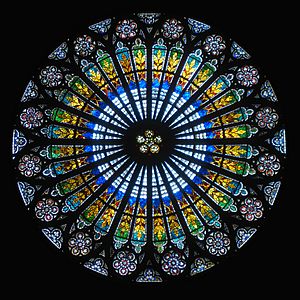
Contents
What is a Rose Window?
A rose window is a large, circular window. It has a central point from which many smaller sections spread out, just like the petals of a flower. These sections are usually made of stone or metal, called "tracery." The spaces between the tracery are filled with pieces of colored glass. When sunlight shines through, it creates a dazzling display of light and color inside the building.
Where Can You Find Them?
You will most often see rose windows in churches and cathedrals. They are a key feature of Gothic architecture, which was popular in Europe from the 12th to the 16th centuries. These windows are often placed high up on the front (west) side of the church, or on the sides (transepts). They let in a lot of light and are a major part of the building's design.
The History of Rose Windows
Round windows have been around for a long time, even before rose windows became famous.
Early Round Windows
The very first round openings in buildings were simple holes called "oculi." An example is the large oculus at the top of the Pantheon, Rome. These early windows were just open holes or sometimes had simple grates. Later, people started adding glass to these round openings.
Gothic Masterpieces
Rose windows really became popular during the Gothic period. Architects learned how to build taller, lighter walls, which allowed for bigger windows. They developed complex stone tracery patterns that looked like intricate lace. These patterns held together many small pieces of stained glass.
Famous examples include the rose windows of Chartres Cathedral and Notre-Dame de Paris. These windows often showed scenes from the Bible or important religious figures. They were not just beautiful; they also helped teach people stories when many could not read.
What Do They Mean?
Rose windows often have deep meanings. The circular shape can represent eternity or the never-ending nature of God. The light shining through the colored glass can symbolize divine light or the presence of God.
Many rose windows show specific stories or symbols. For example, the north rose window of Notre Dame in Paris features the Virgin Mary and Christ Child in the center. Around them are prophets and saints. The north rose of the Abbey of St Denis shows God the Creator surrounded by the days of Creation. These windows were like giant storybooks made of light and color.
Images for kids
-
San Pedro, Ávila, Spain.
-
Reims Cathedral, France
-
The rose window of Lancing College chapel
-
Symbolism: the north rose of the Abbey of St Denis, Paris, showing God the Creator, surrounded by the Days of Creation, the Order of the Heavens represented by the Zodiac and the Order of Earth as represented by the Labours of the Months. In the corners are the Fall of Mankind.
-
The oculus of the Pantheon, Rome
-
Baptistery of St. John of Poitiers, France, 6-7th century
-
Aquileia Basilica, Italy, 11th century
-
Merovingian decorative architectural marble reliefs, 6th century, on display in Baptistery of St. John of Poitiers
-
Common visigothic decoration. Archaeological crypt in Valencia Cathedral, 6–7th century
-
Visigothic design of roses, preislamic, from basilica of Saint Vincent of Lérins of Cordoba, 6–7th century
-
Visigothic window with stone tracery, of Church of San Juan Bautista, Baños de Cerrato, 7th century
-
San Miguel de Lillo, Oviedo, Spain. Towards 850
-
France, Notre-Dame de Paris (1250–1260).
-
Italy, L'Aquila, Basilica of Santa Maria di Collemaggio (1287).
-
Notre-Dame de Paris, France, north transept.
-
France, Sainte-Chapelle, Paris, the Apocalypse in Flamboyant tracery.
-
Sweden, Oscar Frediks Church.
-
Peru, the Presidential Palace
-
Spain, Mallorca, Palma, with a pattern which existed already in the ancient Roman and wisigothic roses.
-
United States, window over the altar in Boston University's Marsh Chapel
See also
 In Spanish: Rosetón para niños
In Spanish: Rosetón para niños








